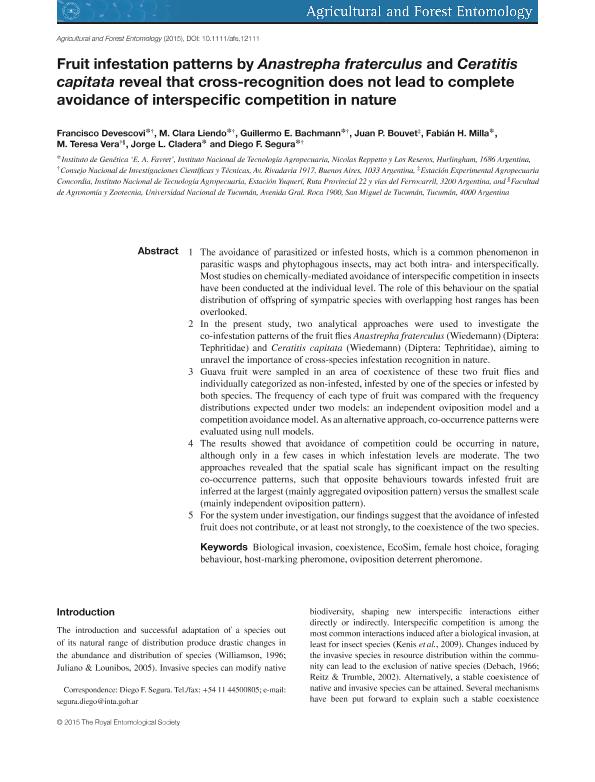Mostrar el registro sencillo del ítem
dc.contributor.author
Devescovi, Francisco

dc.contributor.author
Liendo, María Clara

dc.contributor.author
Bachmann, Guillermo Enrique

dc.contributor.author
Bouvet, Juan Pedro Raúl

dc.contributor.author
Milla, Fabian Horacio

dc.contributor.author
Vera, Maria Teresa

dc.contributor.author
Cladera, Jorge Luis

dc.contributor.author
Segura, Diego Fernando

dc.date.available
2017-02-08T21:32:11Z
dc.date.issued
2015-08
dc.identifier.citation
Devescovi, Francisco; Liendo, María Clara; Bachmann, Guillermo Enrique; Bouvet, Juan Pedro Raúl; Milla, Fabian Horacio; et al.; Fruit infestation patterns by Anastrepha fraterculus and Ceratitis capitata reveal that cross-recognition does not lead to complete avoidance of interspecific competition in nature; Wiley Blackwell Publishing, Inc; Agricultural And Forest Entomology; 17; 3; 8-2015; 325-335
dc.identifier.issn
1461-9555
dc.identifier.uri
http://hdl.handle.net/11336/12767
dc.description.abstract
1- The avoidance of parasitized or infested hosts, which is a common phenomenon in parasitic wasps and phytophagous insects, may act both intra- and interspecifically. Most studies on chemically-mediated avoidance of interspecific competition in insects have been conducted at the individual level. The role of this behaviour on the spatial distribution of offspring of sympatric species with overlapping host ranges has been overlooked.
2- In the present study, two analytical approaches were used to investigate the co-infestation patterns of the fruit flies Anastrepha fraterculus (Wiedemann) (Diptera: Tephritidae) and Ceratitis capitata (Wiedemann) (Diptera: Tephritidae), aiming to unravel the importance of cross-species infestation recognition in nature.
3- Guava fruit were sampled in an area of coexistence of these two fruit flies and individually categorized as non-infested, infested by one of the species or infested by both species. The frequency of each type of fruit was compared with the frequency distributions expected under two models: an independent oviposition model and a competition avoidance model. As an alternative approach, co-occurrence patterns were evaluated using null models.
4- The results showed that avoidance of competition could be occurring in nature, although only in a few cases in which infestation levels are moderate. The two approaches revealed that the spatial scale has significant impact on the resulting co-occurrence patterns, such that opposite behaviours towards infested fruit are inferred at the largest (mainly aggregated oviposition pattern) versus the smallest scale (mainly independent oviposition pattern).
5- For the system under investigation, our findings suggest that the avoidance of infested fruit does not contribute, or at least not strongly, to the coexistence of the two species.
dc.format
application/pdf
dc.language.iso
eng
dc.publisher
Wiley Blackwell Publishing, Inc

dc.rights
info:eu-repo/semantics/openAccess
dc.rights.uri
https://creativecommons.org/licenses/by-nc-sa/2.5/ar/
dc.subject
BIOLOGICAL INVASION
dc.subject
COEXISTENCE
dc.subject
ECOSIM
dc.subject
FEMALE HOST CHOICE
dc.subject
FORAGING BEHAVIOUR
dc.subject
HOST-MARKING PHEROMONE
dc.subject
OVIPOSITION DETERRENT PHEROMONE
dc.subject.classification
Zoología, Ornitología, Entomología, Etología

dc.subject.classification
Ciencias Biológicas

dc.subject.classification
CIENCIAS NATURALES Y EXACTAS

dc.subject.classification
Ecología

dc.subject.classification
Ciencias Biológicas

dc.subject.classification
CIENCIAS NATURALES Y EXACTAS

dc.title
Fruit infestation patterns by Anastrepha fraterculus and Ceratitis capitata reveal that cross-recognition does not lead to complete avoidance of interspecific competition in nature
dc.type
info:eu-repo/semantics/article
dc.type
info:ar-repo/semantics/artículo
dc.type
info:eu-repo/semantics/publishedVersion
dc.date.updated
2017-02-07T17:51:33Z
dc.journal.volume
17
dc.journal.number
3
dc.journal.pagination
325-335
dc.journal.pais
Reino Unido

dc.journal.ciudad
Londres
dc.description.fil
Fil: Devescovi, Francisco. Instituto Nacional de Tecnología Agropecuaria. Centro Nacional de Investigaciones Agropecuarias. Centro de Investigación de Ciencias Veterinarias y Agronómicas. Instituto de Genética; Argentina. Consejo Nacional de Investigaciones Científicas y Técnicas; Argentina
dc.description.fil
Fil: Liendo, María Clara. Instituto Nacional de Tecnología Agropecuaria. Centro Nacional de Investigaciones Agropecuarias. Centro de Investigación de Ciencias Veterinarias y Agronómicas. Instituto de Genética; Argentina. Consejo Nacional de Investigaciones Científicas y Técnicas; Argentina
dc.description.fil
Fil: Bachmann, Guillermo Enrique. Instituto Nacional de Tecnología Agropecuaria. Centro Nacional de Investigaciones Agropecuarias. Centro de Investigación de Ciencias Veterinarias y Agronómicas. Instituto de Genética; Argentina. Consejo Nacional de Investigaciones Científicas y Técnicas; Argentina
dc.description.fil
Fil: Bouvet, Juan Pedro Raúl. Instituto Nacional de Tecnología Agropecuaria. Centro Regional Entre Ríos. Estación Experimental Agropecuaria Concordia. Agencia de Extensión Rural Concordia; Argentina
dc.description.fil
Fil: Milla, Fabian Horacio. Instituto Nacional de Tecnología Agropecuaria. Centro Nacional de Investigaciones Agropecuarias. Centro de Investigación de Ciencias Veterinarias y Agronómicas. Instituto de Genética; Argentina
dc.description.fil
Fil: Vera, Maria Teresa. Consejo Nacional de Investigaciones Científicas y Técnicas. Centro Científico Tecnológico Conicet - Tucumán; Argentina. Universidad Nacional de Tucumán. Facultad de Agronomía y Zootecnia; Argentina
dc.description.fil
Fil: Cladera, Jorge Luis. Instituto Nacional de Tecnología Agropecuaria. Centro Nacional de Investigaciones Agropecuarias. Centro de Investigación de Ciencias Veterinarias y Agronómicas. Instituto de Genética; Argentina
dc.description.fil
Fil: Segura, Diego Fernando. Instituto Nacional de Tecnología Agropecuaria. Centro Nacional de Investigaciones Agropecuarias. Centro de Investigación de Ciencias Veterinarias y Agronómicas. Instituto de Genética; Argentina. Consejo Nacional de Investigaciones Científicas y Técnicas; Argentina
dc.journal.title
Agricultural And Forest Entomology

dc.relation.alternativeid
info:eu-repo/semantics/altIdentifier/doi/http://dx.doi.org/10.1111/afe.12111
dc.relation.alternativeid
info:eu-repo/semantics/altIdentifier/url/http://onlinelibrary.wiley.com/doi/10.1111/afe.12111/abstract
Archivos asociados
